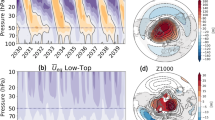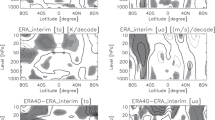Abstract
This study discusses the results of comprehensive time-dependent, three-dimensional numerical modelling of the circulation in the middle atmosphere obtained with the GFDL “SKYHI” troposphere-stratosphere-mesosphere general circulation model (GCM). The climate in a long control simulation with an intermediate resolution version (≈3° in horizontal) is briefly reviewed. While many aspects of the simulation are quite realistic, the focus in this study is on remaining first-order problems with the modelled middle atmospheric general circulation, notably the very cold high latitude temperatures in the Southern Hemisphere (SH) winter/spring, and the virtual absence of a quasi-biennial oscillation (QBO) in the tropical stratosphere. These problems are shared by other extant GCMs. It was noted that the SH cold pole problem is somewhat ameliorated with increasing horizontal resolution in the model. This suggests that improved resolution increases the vertical momentum fluxes from the explicitly resolved gravity waves in the model, a point confirmed by detailed analysis of the spectrum of vertical eddy momentum flux in the winter SH extratropics. This result inspired a series of experiments with the 3° SKYHI model modified by adding a prescribed zonally-symmetric zonal drag on the SH winter westerlies. The form of the imposed momentum source was based on the simple assumption that the mean flow drag produced by unresolved waves has a spatial distribution similar to that of the Eliassen-Palm flux divergence associated with explicitly resolved gravity waves. It was found that an appropriately-chosen drag confined to the top six model levels (above 0.35 mb) can lead to quite realistic simulations of the SH winter flow (including even the stationary wave fields) through August, but that problems still remain in the late-winter/springtime simulation. While the imposed momentum source was largely confined to the extratropics, it produced considerable improvement in the simulation of the equatorial semiannual oscillation, with both the easterly and westerly phases being somewhat more intense than in the control simulation. A separate experiment was conducted in which the SKYHI model was simplified so that it had no topography and so that the seasonal cycle was frozen in perpetual equinox conditions. These changes result in a model that has much reduced interhemispheric asymmetry. This model spontaneously produces a long period mean flow oscillation of considerable amplitude in the tropical upper stratopause. The implication of this result for the general issue of obtaining a QBO in comprehensive GCMs is discussed.
Similar content being viewed by others
References
Andrews DG, Mahlman JD, Sinclair RW (1983) Eliassen-Palm diagnostics of wave-mean flow interaction in the GFDL “SKYHI” general circulation model. J Atmos Sci 40:2768–2784
Bates HR (1977) Dynamics of stationary ultra-long waves in middle latitudes. Q J R Meteorol Soc 103:397–430
Boville BA (1984) The influence of the polar night jet on the tropospheric circulation in a GCM. J Atmos Sci 41:1132–1142
Boville BA (1991) Sensitivity of the simulated climate to model resolution. J Clim 4:469–485
Boville BA, Randel WJ (1992) Equatorial waves in a stratospheric GCM: effects of vertical resolution. J Atmos Sci 49:785–801
Cariolle D, Amodei M, Deque M, Mahfouf J-F, Simon P, Teyssedre H (1993) A quasi-biennial oscillation signal in general circulation model simulations. Science 261:1313–1316
Fels SB, Mahiman JD, Schwarzkopf MD, Sinclair RW (1980) Stratospheric sensitivity to perturbations in ozone and carbon dioxide: radiative and dynamical responses. J Atmos Sci 37:2265–2297
Fleming EL, Chandra S, Schoeber MR, Barnett JJ (1988) Monthly mean global climatology of temperature, wind, geopotential height, and pressure for 0–120 km. NASA Techn Memor 100697
Fritts DC (1984) Gravity wave saturation in the middle atmosphere: a review of theory and observation. Rev Geophys Space Phys 22:275–308
Garcia RR (1991) Parameterization of planetary wave breaking in the middle atmosphere. J Atmos Sci 48:1405–1419
Garcia RR, Solomon S (1985) The effect of breaking gravity waves on the dynamics and chemical composition of the mesosphere and lower thermosphere. J Geophys Res 90:3850–3868
Garcia RR, Boville BA (1994) “Downward control” of the mean meridional circulation and temperature distribution of the polar winter stratosphere. J Atmos Sci 51:2238–2245
Geller MA, Alpert JC (1980) Planetary wave coupling between the troposphere and stratosphere as a possible sun-weather mechanism. J Atmos Sci 37:1197–1215
Hamilton K (1993) What we can learn from general circulation models about the spectrum of middle atmospheric motions. In: Thrane E, Blix T, Fritts D (eds) Coupling processes in the lower and middle atmosphere. Kluwer, London, pp 161–174
Hamilton K (1995) Interannual variability in the Northern Hemisphere winter middle atmosphere in control and perturbed experiments with the SKYHI general circulation model. J Atmos Sci 52:44–66
Hamilton K, Mahlman JD (1988) General circulation model simulation of the semiannual oscillation in the tropical middle atmosphere. J Atmos Sci 45:3212–3235
Hamilton K, Yuan L (1992) Experiments on tropical stratospheric mean wind variations in a spectra general circulation model. J Atmos Sci 49:2464–2483
Hamilton K, Wilson RJ, Mahlman JD, Umscheid LJ (1995) Climatology of the GFDL SKYHI troposphere-stratosphere-mesosphere general circulation model. J Atmos Sci 52:5–43
Hayashi Y, Golder DG, Mahlman JD (1984) Stratospheric and mesospheric Kelvin waves simulated in the “SKYHI” general circulation model. J Atmos Sci 41:1971–1984
Hayashi Y, Golder DG (1994) Kelvin and mixed Rossby-gravity waves appearing in the GFDL SKYHI general circulation model and the FGGE dataset: implications for the generation mechanism and role of the QBO. J Meteorol Soc Japan 72:901–935
Hayashi Y, Mahlman JD, Miyahara S (1989) The effect of horizontal resolution on gravity waves simulated by the GFDL SKYHI general circulation model. Pure Appl Geophys 130:421–443
Haynes PH, Marks CJ, McIntyre ME, Shepperd TG, Shine KP (1991) On the “downward control” of extratropical diabatic circulations by eddy-induced mean zonal forces. J Atmos Sci 48:651–678
Hines CO (1974) A possible mechanism for production of sunweather correlations. J Atmos Sci 31:589–591
Holton JR (1982) The role of gravity wave induced drag and diffusion in the momentum budget of the mesosphere. J Atmos Sci 39:791–799
Holton JR, Lindzen RS (1972) An updated theory for the quasibiennial oscillation. J Atmos Sci 29:1076–1080
Kantor AJ, Cole AE (1964) Zonal and meridional winds to 120 kilometers. J Geophys Res 69:5131–5140
Lindzen RS (1981) Turbulence and stress due to gravity wave breakdown. J Geophys Res 86:9707–9714
McFarlane NA (1987) The effect of orographically excited gravity-wave drag on the general circulation of the lower stratosphere and troposphere. J Atmos Sci 44:1775–1800
Mahlman JD, Umscheid LJ (1984) Dynamics of the middle atmosphere: Successes and problems of the GFDL “SKYHI” general circulation model. In: Holton JR, Matsuno T (eds) Dynamics of the middle atmosphere. Terra Scientific, pp 501–525
Mahlman JD, Umscheid LJ (1987) Comprehensive modeling of the middle atmosphere: the influence of horizontal resolution. In: Visconti G, Garcia R (eds) Transport processes in the middle atmosphere. D. Riedel, Dordrecht, pp 251–266
Manabe S, Hunt BG (1968) Experiments with a stratospheric general circulation model, I radiative and dynamical aspects. Mon Weather Rev 96:477–502
Manabe S, Mahlman JD (1976) Simulation of seasonal and interhemispheric variations in the stratospheric circulation. J Atmos Sci 33:2185–2217
Manzini E, Hamilton K (1993) Middle atmospheric travelling waves forced by latent and convective heating. J Atmos Sci 50:2180–2200
Miyahara S, Hayashi Y, Mahlman JD (1986) Interactions between gravity waves and the planetary scale flow simulated by the GFDL “SKYHI” general circulation model. J Atmos Sci 43:1844–1861
Palmer TN, Shutts GJ, Swinbank R (1986) Alleviation of a systematic westerly bias in general circulation and numerical weather prediction models through an orographic gravity wave parameterization. Q J R Meteorol Soc 112:1001–1039
Plumb RA (1977) The interaction of two internal waves with the mean flow: implications for the theory of the quasi-biennial oscillation. J Atmos Sci 34:1847–1858
Ramanathan V (1977) Tropospheric-stratospheric feedback mechanism: stratospheric warming and its effects on the polar energy budget and the tropospheric circulation. J Atmos Sci 34:439–447
Randel WJ (1992) Global atmospheric circulation statistics, 1000-1 mb. NCAR Techn Note TN-366+STR
Rind D, Suozzo R, Balachandran NK, Lacis A, Russell G (1988a) The GISS global climate-middle atmosphere model. Part I: model structure and climatology. J Atmos Sci 45:329–370
Rind D, Suozzo R, Balachandran NK (1988b) The GISS global climate-middle atmosphere model. Part II: model variability due to interactions between planetary waves, the mean circulation and gravity wave drag. J Atmos Sci 45:371–386
Saravanan R (1990) A multiwave model of the quasi-biennial oscillation. J Atmos Sci 47:2465–2474
Sassi F, Garcia RR, Boville BA (1993) The stratopause semiannual oscillation in the NCAR Community Climate Model. J Atmos Sci 50:3608–3624
Shine K (1989) Sources and sinks of zonal momentum in the middle atmosphere using the diabatic circulation. Q J R Meteorol Soc 115:265–292
Takahashi M, Shiobara M (1995) A note on a QBO-like oscillation in the 1/5 sector CCSR/NIES GCM. J Meteorol Soc Japan 73:131–137
Author information
Authors and Affiliations
Rights and permissions
About this article
Cite this article
Hamilton, K. Comprehensive simulation of the middle atmospheric climate: some recent results. Climate Dynamics 11, 223–241 (1995). https://doi.org/10.1007/BF00215009
Received:
Accepted:
Issue Date:
DOI: https://doi.org/10.1007/BF00215009




